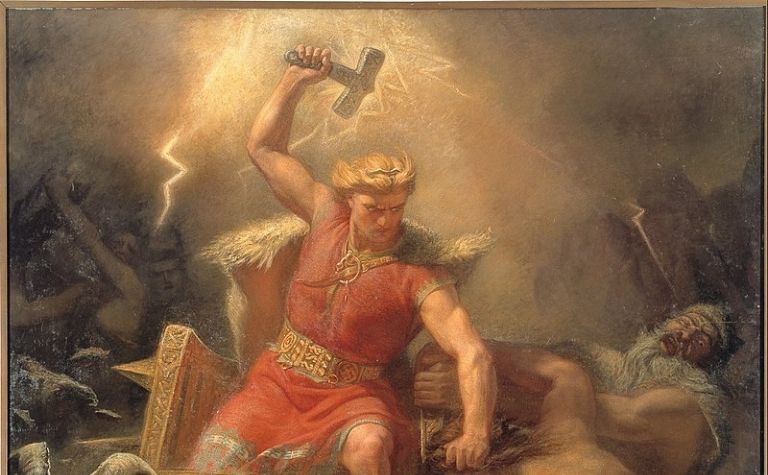The old Norse religion is full of fascinating characters, such as Odin, Thor, and Loki. These figures are staples of popular culture and are just as iconic as many Greek, Roman, and Egyptian gods.
But historians know remarkably little about how the Norsemen worshipped their old gods.
The Norse religion fell out of practice because of the spread of Christianity. Some people still practice the Norse religion, but it’s not nearly as widespread as it was before the arrival of Christianity in Scandinavia.
Christianity is also the reason why historians know relatively little about the Norse religion.
Artifacts and temples to the Norse gods were destroyed or converted, and most records of the Norse religion were written by Christians decades or centuries after the Norse conversion to Christianity.
Very little ancient Norse history remains untouched by Christianity.
Also, see Is The Norse Religion Still Practiced? to learn more.

When Did the Norse Religion Decline?
The Vikings didn’t convert to Christianity overnight. Their conversion took place slowly, across decades, as people blended the Norse religion with Christian beliefs.
The two religions were practiced concurrently until Christian authorities insisted on their religion being the only one.
The Norse religion began to decline in the 11th century. By the middle of the 12th century, Christianity was firmly established as the dominant religion of Scandinavia.
Historians are unsure when Christianity first came to Scandinavia, but it was well before the 11th century.
The Vikings had contact with Europe at least as early as the 700s and some Christians lived in coastal trade towns in Scandinavia.
The Norse practiced their pagan religion peacefully alongside the Christians, and some even followed elements of both religions.
Christian missionaries started traveling to Scandinavia in the year 725, though they had little effect. [1]
Larger waves of missionaries ventured to Denmark and Sweden in the 800s, led by St. Ansgar.
Historians believe that the many settlements had their religion determined by their chieftains. If the ruler converted, so did his people.
Between the 10th and 12th centuries, the rulers of Scandinavian countries pushed for national conversion to Christianity.
Harald Bluetooth of Denmark claimed to “make the Danes Christian” at the end of the 10th century.
Olaf Haraldsson led Norway to Christianity in the early 11th century. Sweden, however, took until the 12th century to fully convert away from the old gods.
The period during which the Norse religion fell to Christianity almost perfectly coincides with what scholars today call the Viking Age.
The Viking Age covers 793 to 1066. It was a period when the Scandinavians interacted heavily with other countries, both in trade and battle.
These interactions probably helped speed up the Vikings’ conversion.
Also, see Can A Person Convert to the Norse Religion? to learn more.

What Factors Caused the Norse Religion To Decline?
Every Viking who chose to convert from Norse paganism to Christianity must have had complex and personal reasons for doing so.
Historians can only speculate why the Vikings abandoned their old gods, and the answer largely appears to be for convenience.
Conversion to Christianity allowed the Vikings to more easily trade with and marry other Europeans, and it avoided war with the Holy Roman Empire.
The Norse religion declined due to the spread of Christianity in Scandinavia. Some Vikings converted to Christianity due to personal conviction, but many adopted the faith for financial reasons.
They accepted Christianity to trade and form political alliances with Christian nations in Europe.
When the Vikings first adopted Christian beliefs, they simply added Christ to their pantheon of gods. The Norse religion included many gods, so many Vikings worshipped Jesus alongside Thor.
This joint worship is most apparent in one archeological find at the National Museum of Denmark. There’s a casting mold used to make religious trinkets.
It features two crosses and Thor’s hammer side-by-side, indicating that the smith regularly made jewelry for both faiths.
Christian merchants in Europe were more comfortable doing business with other Christians instead of pagans. As a result, many Vikings adopted the Christian faith to make business deals.
The Vikings also had to consider the Holy Roman Empire to the south of Denmark.
The Empire might have gone to war if the Vikings did not convert willingly. The Viking rulers opted to convert peacefully instead of fighting with them.
As more Scandinavian kings converted to Christianity, they started enforcing more of the religion’s rules.
Though the Norse religion allowed the Vikings to worship more than one god, Christianity didn’t. Christianity slowly became the dominant religion, with the Norse gods worshipped only in secret.
Also, see Is the Norse Religion Older Than Judaism? to learn more.

What Does Norse Religion Look Like Today?
A thousand years after the Vikings converted to Christianity, their countries are still largely Christian.
But there’s a growing population of Scandinavians who want to connect with their roots and reclaim their ancestors’ religion.
Some Scandinavians still practice the old Norse religion called Asatru. Nordic countries are still predominantly Christian, but several small groups practice Asatru.
Asatru, sometimes called Asatro or Norse paganism, is the revival of the old Norse religion.
Many followers of Asatru don’t take the old Norse myths literally.
They have no standardized teachings, so each follower can interpret the texts for himself.
Asatru practitioners typically worship outdoors to better connect with nature.
They meet at historical sites that their ancestors used before the introduction of Christianity.
Four times a year, at the solstices and equinoxes, followers of Asatru give offerings to the Norse gods at these sites.
At these offering ceremonies, an Asatru priest leads the group in calling out to the Norse gods.
The practitioners stand in a circle to form a portal to the gods.
They pour offerings of mead, burn herbs or branches, and leave the gods food and other gifts.
They might ask the gods for fertility, strength, or wisdom. A communal meal may follow offerings.
In Iceland, Asatru is the largest non-Christian religion today. Asatru is also a legally recognized faith in Denmark, Sweden, and Norway. [2]
The resurgence of the old Norse religion seems to be a reaction to centuries of Christianity.
Christianity is not native to Scandinavia, so many people have chosen to reclaim the faith that their ancestors gave up.
Also, see Do People Still Believe In Odin? to learn more.
Conclusion
When Christianity spread to Scandinavia, it left no room for the old Norse gods. But modern-day believers have given new life to the old faith.
